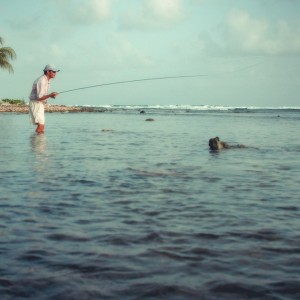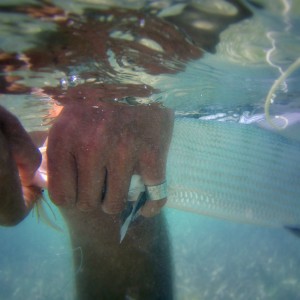This is a guest post by Davin over at Flatswalker. When I spouted off about “It’s the reel” he replied. I thought you all might like a little more light shed on his views (as I did). Tomorrow, I’ll reply with my own thoughts (here is that post). But for today…
TRUST ME, IT’S THE ROD
I’m a tackle snob. I try not to be, but there it is. I might not own the best gear, but I think I do. I have a penchant for ultra-light, yet sturdy tackle, and generally believe in “Final Decisions”—that is, spending time and (often good) money to buy something once, and own it pretty much for life.†
However, in my line of work I do get to cast a lot of rods in a lot of price ranges. I also get to watch folks compare their rods and mine. My conclusion: Rods matter. I’ll go farther and say it’s about the most important decision you can make before embarking on a bonefishing trip.
We tend to fall back on habit when our brains shut off at the sight of a tailing bonefish (or when the guide starts yelling cast now, cast now, 40 feet!) Then we revert to our default cast—the cast we’ve practiced most and is the most natural for us, regardless of the rod in hand. If you’ve chosen your rod correctly then you’re in great shape when you have to rely on instinct.

When you don’t have a lot of time, you need to feel the rod.
Here’s The Problem: most of us don’t chose our rods correctly, especially for salt water. Our choices are usually based on arbitrary criteria like affordability, or “Orvis is for posers” or “my buddy/the fly-shop guy/Andy Mills says these rods are awesome and he knows way more than me” or (worst of all) how far we can cast the rod.
The critical factor in choosing a rod is how you cast. Is your casting stroke short, long, relaxed, fast? Can you double haul? Do you have great timing instead? These are actually the first questions you need to ask when selecting a rod. How far you can cast it will have next-to-nothing to do with how it actually fishes. Trust me.
In fact, I’d say that needing to distance cast is a relatively narrow niche in saltwater fishing—especially sight fishing. Generally you’re called upon to reach that redfish at 40 feet, or that bonefish at 50. Maybe you need a longer string for spooky permit, but you’ll likely be using a 10-weight at that point so 60 feet shouldn’t be too much trouble. Any farther than that and—for sight fishing—you’re into the realms of fantasy. Even if you can bomb it out there to 80 feet—unlikely—you probably won’t be accurate enough to put the fly where it needs to be to feed the fish.
Ok, there are some aspects of bonefishing that might be obvious but I should have listed at the outset.
- First, you need to see the fish. This will usually happen between 25 and 80 feet. Any farther and you probably won’t be able to see it—bonefish being relatively small, excellently camouflaged fish in a giant ocean. Any closer and you’ve probably already spooked it.
- The fish has to see your fly. Hail-Mary cast in the general direction won’t get it done. You’ve got to place the fly deliberately where the fish can see it without spooking it so that you can…
- Feed the fish. This is the bottom line. If you can’t reach the fish before it gets too close, or put the fly where the fish can see it, then you won’t feed it.
That is what this is all about and my experience with rods is that most have holes in their performance. This is particularly true with the new generation of fast-action sticks, the true rocket launchers that make us feel like we can reach any fish on the horizon.
Here’s the straight skinny: ultra-fast rods are the worst rods for bonefishing. I say this for both the expensive and inexpensive sticks. If you can’t feel a rod with less than 30 feet of line out the tip, you’ll miss most bonefish. Bonefishing happens between 30-50 feet. That’s pretty close, and they’re usually moving toward you. You have very little time to get the fly out and feed the fish. If you’ve got to make half-dozen false casts just to load the rod, that fish will be inside 30 feet by then and you’re done. Game over. Redo from start. What you really need is a rod that allows you to cast to that sweet spot in 1-2 false casts. You should not be struggling to feel the rod, and you should be able to accurately present the fly inside 30 feet.
Before you protest, think this through. Your rod is roughly ten feet long, so is your leader. That means with only five feet of fly line out the rod you’ve got close to 25 feet. How many rods do you think allow you to feel five feet of fly line? ‡
See what I mean? Too far is rarely a problem. What is a problem is accuracy, and that means casting the right rod for you, first of all, and then considering the conditions you’ll be fishing in. We’re talking bonefishing here, and that means breeze—8-18 knots all the time—and the varying distances depending on if you’re wading or being poled. For wading practice 30-50 foot casts, with a few shots inside or outside. If you’re on a skiff then 40-60 feet. Flies will be relatively small and light—generally #6-#2 hooks with medium bead-chain to medium lead eyes for weight. The perfect bonefish rod will allow you to easily load the rod in close and still reach the medium distances of 50-60 feet in these conditions. It is a lot to ask of a rod, so take your time and choose wisely.

The rod, the reel AND the beer. Perfect.
†Obviously, not every purchase falls into this category. Beer, bread, and boxer shorts, for instance, seem like ongoing investments… at least for the foreseeable future.
‡ Plenty; they’re called 3-weights.







